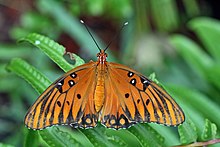Gulf Fritillary
| Gulf fritillary | |
|---|---|
 |
|
| Upperside | |
 |
|
| Underside | |
| Scientific classification | |
| Kingdom: | Animalia |
| Phylum: | Arthropoda |
| Class: | Insecta |
| Order: | Lepidoptera |
| Family: | Nymphalidae |
| Genus: |
Agraulis (Boisduval & Le Conte, 1835) |
| Species: | A. vanillae |
| Binomial name | |
|
Agraulis vanillae (Linnaeus, 1758) |
|
The Gulf fritillary or passion butterfly (Agraulis vanillae) is a bright orange butterfly of the family Nymphalidae and subfamily Heliconiinae. That subfamily was formerly set apart as a separate family, the Heliconiidae. The Heliconiinae are "longwing butterflies", and like other longwings this species does have long, rather narrow wings in comparison with other butterflies. It is not closely related to the true fritillaries, however. It is the only member of genus Agraulis.
The Gulf fritillary is a medium-to-large butterfly, with a wingspan of 6–9.5 cm (2.4–3.7 in). Its underwings are buff, with large silvery spots. It takes its common name from its migration over the Gulf of Mexico.
It was first illustrated by Maria Sybilla Merian in Suriname.
The Gulf fritillary is commonly seen in parks and gardens, as well as in open country. Its range extends from Argentina north through Central America, Mexico, and the Caribbean to the southern United States, as far north as the San Francisco Bay Area on the west coast. It is occasionally farther north.
The larva is a caterpillar which grows to approximately 4 cm (1.6 in) in length. It is bright orange in color and covered in rows of black spines. The spines are soft to the touch and do not sting, but the larva is poisonous if eaten. The larva feeds exclusively on species of passionflower, such as maypop (Passiflora incarnata), yellow passionflower (P. lutea), and running pop (P. foetida).
...
Wikipedia
